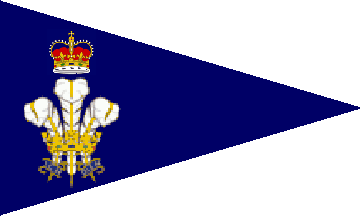 image
by Peter Hans van den Muijzenberg, 2 June 2014
image
by Peter Hans van den Muijzenberg, 2 June 2014
Last modified: 2014-07-19 by rob raeside
Keywords: royal welsh yacht club |
Links: FOTW homepage |
search |
disclaimer and copyright |
write us |
mirrors
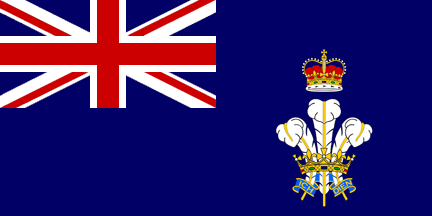 image
by Clay Moss, 8 July 2014
image
by Clay Moss, 8 July 2014See also:
Other sites:
The Royal Welsh Yacht Club was established in 1847. As the Admiralty
warrant is from 5 May of the same year, it's likely the club started out with
these designs, rather than with a burgee with an uncrowned badge of the
Prince of Wales. (I don't know whether using that badge would have required
permission to begin with.)
No mention is made of the permission to call
the club "Royal", but since the club was established under patronage of the
Dowager Queen Adelaide it's likely they had this
permission from the outset. The club has had Royal Patronage ever since.
The club is located in the Royal Town of Caernarfon, where the first
English Prince of Wales was proclaimed. Its club house is the town's sea
gate, which was built in approximately 1285 (the club mentions both 1284 and
1285), which means it may well be the oldest yacht club house in the world.
The town is situated on the Menai Strait, which separates it from Anglesey,
and approximately two miles down the strait are the waters of the Irish Sea.
The RWYC engages in both racing and cruising, and is also active in sea
rowing. The club is quite aware of all the history surrounding them and its
status of Wales’s senior yacht club. At the same time they are a welcoming
group, with non-members welcome to participate in club activities.
Peter Hans van den Muijzenberg, 2 June 2014
Warrant granted 5 November 1847.
David Prothero, 7 June 2014
The Royal Welsh Yacht Club holds a warrant for a blue ensign defaced with the
club badge, the Prince of Wales feathers. This was originally granted in 1847.
More information can be found on the club website (http://www.royalwelshyachtclub.org.uk/?page_id=131).
Debbie Parsons,, 31 May 2014
The Royal Welsh Yacht Club (RWYC), <http://www.royalwelshyachtclub.org.uk>,
has a burgee, pictured at
http://www.royalwelshyachtclub.org.uk/?page_id=20&id=180861488631225. It's a
blue 3:5 triangular British Royal Navy blue field, with the badge of the Prince
of Wales with above it a St. Edwards crown.
The Dumpy Pocketbook of
Sailing Dinghies and Yachts [1960] p. 117 agrees with that picture, but shows a
more stylised badge. Yacht Club Burgees - Colin Stewart Stewart [1957] has the
same, and also indicates a blue ensign with the same design. It may be that the
design changed, that the depiction changed, or that not all the pictures are
equally accurate. Flying colours <http://www.flyingcolours.org/product/yacht-club-flags/royal-welsh-yacht-club-burgee.html>
picture the burgee similarly to the club, but in the photograph it looks
different.
The club's constitution, as changed 24 November 2012
<http://www.royalwelshyachtclub.org.uk/?page_id=514> [which by its own
text
should already be out of date by now], includes the following article:
84. CLUB FLAG AND INSIGNIAPeter Hans van den Muijzenberg, 2 June 2014
The Club Flag is the Blue Ensign with the Crown and the Plume in the fly and the Club Burgee is blue with the Crown and Plume, in accordance to the Admiralty Warrant dated the fifth day of May 1847, the hoist to be two thirds of the length. The Commodore’s Pennant bears the device of the Club with Swallow Tail. The Vice Commodore’s the same, with the addition of one white ball in the upper corner next to the hoist, and Rear Commodore’s the same, but with the addition of two white balls. Past Commodores shall fly the device of the Club on a square blue flag.
 image
by Peter Hans van den Muijzenberg, 2 June 2014
image
by Peter Hans van den Muijzenberg, 2 June 2014
The Dumpy Book of Ships and the Sea (1957)
shows the burgee blue with the Prince of Wales ostrich feathers,
surmounted by a crown.
James Dignan, 12 February 2008
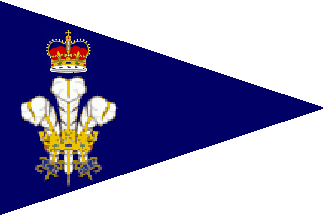 image
by Peter Hans van den Muijzenberg, 2 June 2014
image
by Peter Hans van den Muijzenberg, 2 June 2014
The burgee is specified de jure to be 2:3, rather than 3:5 as the club
pictures it. I've left in the full
badge, though the constitution refers to it as the "Plume".)
Peter Hans van den Muijzenberg, 2 June 2014
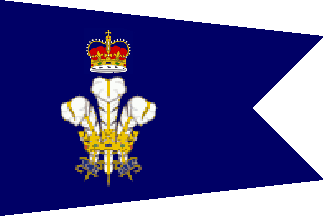 image
by Peter Hans van den Muijzenberg, 2 June 2014
image
by Peter Hans van den Muijzenberg, 2 June 2014
The Commodore has a swallowtail. The constitution gives no different
ratio for the officers flags, so presumably 2:3 as well.
Peter Hans van den Muijzenberg, 2 June 2014
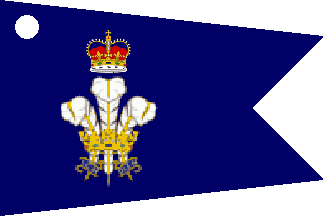 image
by Peter Hans van den Muijzenberg, 2 June 2014
image
by Peter Hans van den Muijzenberg, 2 June 2014
The Vice Commodore with the usual problem of the size of the ball. I went for a small size, so
the badge doesn't have to be moved further towards the fly.
Peter Hans van den Muijzenberg, 2 June 2014
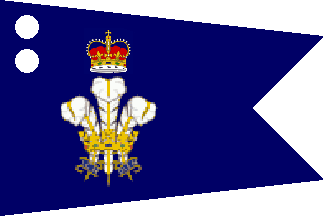 image
by Peter Hans van den Muijzenberg, 2 June 2014
image
by Peter Hans van den Muijzenberg, 2 June 2014
The Rear Commodore, where I picked vertically adjacent as the style to double
the ball. I have yet to find the pattern in this, though, so they may equally
well be using horizontally adjacent or two corners.
Peter Hans van den Muijzenberg, 2 June 2014
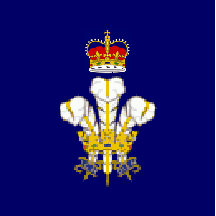 image
by Peter Hans van den Muijzenberg, 2 June 2014
image
by Peter Hans van den Muijzenberg, 2 June 2014
Past Commodores: I've used the same position for the charge that I used for the current
officers flags, which centres the charge. It may be that the charge is
closer to the hoist, to resemble the placement in the other flags more.
Peter Hans van den Muijzenberg, 2 June 2014